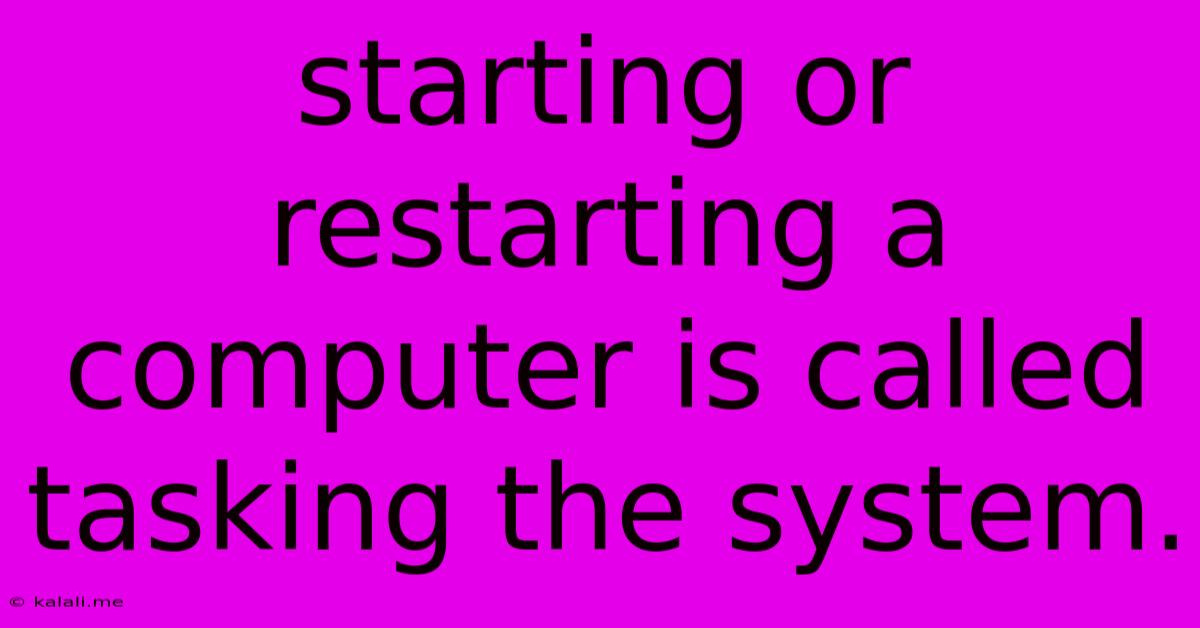Starting Or Restarting A Computer Is Called Tasking The System.
Kalali
Jun 12, 2025 · 3 min read

Table of Contents
Starting or Restarting a Computer is Called Tasking the System: Debunking the Myth
The statement "starting or restarting a computer is called tasking the system" is incorrect. While starting or restarting a computer does involve tasks, it's not accurately described as "tasking the system" in the typical technical sense. This article will clarify the common misunderstanding and explain the actual processes involved. Understanding the true nature of these processes is vital for anyone seeking to troubleshoot computer issues or simply grasp fundamental computer operations.
This meta description explains that the claim in the title is false, clarifies the actual processes involved in starting and restarting a computer, and highlights the importance of understanding these processes for troubleshooting and general computer knowledge.
What Actually Happens When You Start or Restart Your Computer?
When you start or restart your computer, a complex sequence of events unfolds, involving several key processes:
-
Power-On Self-Test (POST): The computer's BIOS (Basic Input/Output System) or UEFI (Unified Extensible Firmware Interface) performs a self-test, checking the hardware components (memory, hard drive, CPU, etc.). This is crucial to ensure everything is functioning correctly before loading the operating system. Any errors detected here will usually result in error messages.
-
Bootloader: The bootloader, a small program, is loaded. Its job is to locate and load the operating system (like Windows, macOS, or Linux).
-
Operating System Loading: The operating system loads its core files and services. This includes loading the kernel (the core of the OS), drivers for hardware devices, and system processes.
-
Startup Applications: Finally, the operating system launches any applications configured to start automatically. These might include antivirus software, cloud synchronization services, or other programs.
These processes collectively initiate the operational readiness of your computer. It's a complex process involving system initialization, hardware checks, and software loading – a far cry from a simple "tasking."
Understanding "Tasking" in a Computing Context
The term "tasking" generally refers to the management of individual processes or applications within an already running operating system. A task manager (found in most operating systems) allows you to monitor and manage these individual processes, identifying resource-intensive applications or those consuming excessive CPU or memory. Starting or restarting the computer is a more fundamental process preceding the management of individual tasks.
Common Misconceptions
The confusion might stem from the fact that starting a computer initiates a series of tasks. However, this initiation process is fundamentally different from the runtime management of individual tasks within the operating system. Using "tasking the system" to describe starting or restarting the computer is a significant oversimplification and technically inaccurate.
Conclusion
While starting or restarting a computer involves many tasks, it's not accurately described as "tasking the system." The boot process is a distinct phase of the computer's operation, preceding the management of individual processes or tasks within the operating system. Understanding the difference clarifies crucial aspects of computer operation and troubleshooting. Instead of "tasking the system," consider describing this process as booting or rebooting the system, which are more precise and technically accurate terms.
Latest Posts
Latest Posts
-
What Is A Literal In Boolean Algebra
Jun 13, 2025
-
Which Of The Following Is Secondary Pollutant
Jun 13, 2025
-
Which Seismic Waves Are Most Destructive
Jun 13, 2025
-
Select The Correct Statement Regarding Synapses
Jun 13, 2025
-
Ugc Net Previous Year Question Paper
Jun 13, 2025
Related Post
Thank you for visiting our website which covers about Starting Or Restarting A Computer Is Called Tasking The System. . We hope the information provided has been useful to you. Feel free to contact us if you have any questions or need further assistance. See you next time and don't miss to bookmark.